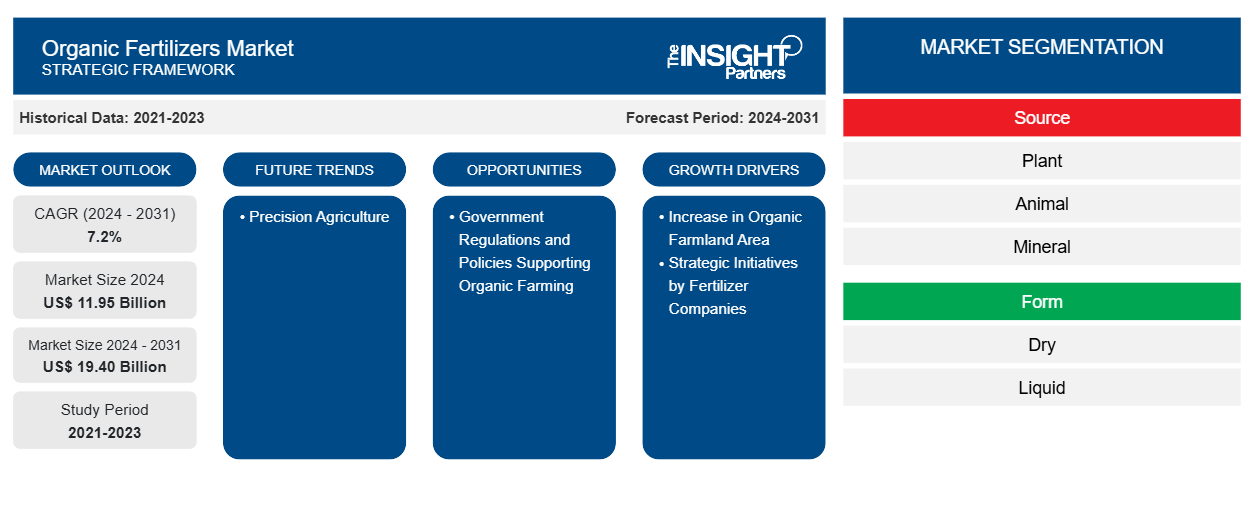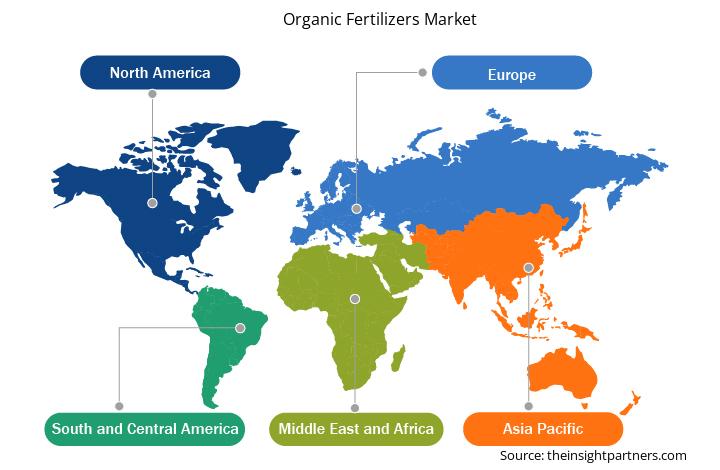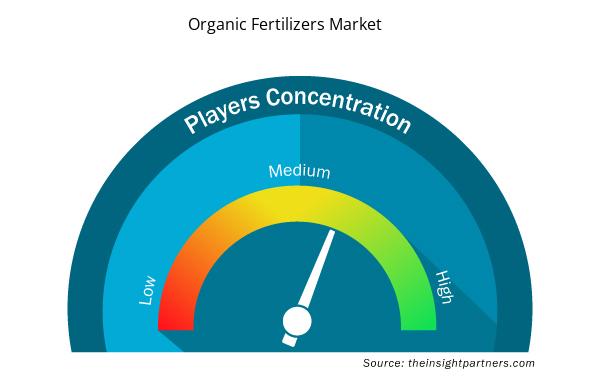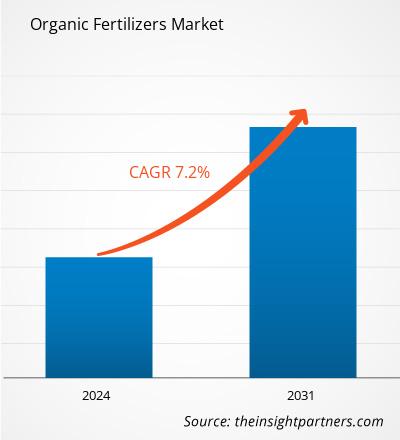Der Markt für organische Düngemittel wird voraussichtlich von 11,95 Milliarden US-Dollar im Jahr 2024 auf 19,40 Milliarden US-Dollar im Jahr 2031 anwachsen. Für den Zeitraum 2024–2031 wird eine durchschnittliche jährliche Wachstumsrate (CAGR) von 7,2 % erwartet. Die Einführung der Präzisionslandwirtschaft dürfte im Prognosezeitraum neue Wachstumstrends im Markt für organische Düngemittel mit sich bringen und so potenzielle Geschäftsfelder schaffen.
Marktanalyse für organische Düngemittel
Beim Zerfall organischer Materialien werden Nährstoffe allmählich freigesetzt, wodurch die Pflanzen langsam, aber stetig mit Nährstoffen versorgt werden. Im Gegensatz dazu liefern synthetische Düngemittel zwar oft schnell Nährstoffe, können aber zu Nährstoffungleichgewichten, Bodenversauerung und langfristiger Erschöpfung der organischen Bodensubstanz führen. Darüber hinaus erhöhen organische Düngemittel die mikrobielle Aktivität im Boden und fördern so ein vielfältiges und ausgewogenes Ökosystem, das den Nährstoffkreislauf, die Pflanzengesundheit sowie die Widerstandsfähigkeit gegen Schädlinge und Krankheiten unterstützt. Obwohl organische Düngemittel sehr nützlich sind, haben sie einige Einschränkungen. Sie liefern in der Regel geringere Nährstoffkonzentrationen als synthetische Düngemittel, sodass größere Mengen erforderlich sein können, um die gleichen Ergebnisse zu erzielen. Der Nährstoffgehalt organischer Düngemittel kann je nach Quelle und Verarbeitungsverfahren variieren, was die Vorhersage des genauen Nährstoffprofils erschwert. Trotz dieser Herausforderungen erfreut sich organischer Düngemittel zunehmender Beliebtheit, insbesondere bei Gärtnern, Biobauern und Fachkräften, die sich auf nachhaltige Landwirtschaft konzentrieren. Landwirte und Gärtner können durch den Einsatz organischer Düngemittel ihre Umweltbelastung reduzieren, die Artenvielfalt fördern und gesündere, widerstandsfähigere Ökosysteme schaffen. Insgesamt sind organische Düngemittel von entscheidender Bedeutung für die langfristige Erhaltung der Bodenfruchtbarkeit und die Förderung der Gesundheit von Pflanzen und Umwelt.
Marktübersicht für organische Düngemittel
Organische Düngemittel werden auf natürliche Weise aus pflanzlichen, tierischen und mineralischen Quellen gewonnen und liefern Pflanzen wichtige Nährstoffe. Organische Düngemittel verbessern die Bodenfruchtbarkeit und fördern nachhaltige landwirtschaftliche Praktiken, indem sie die Bodenstruktur stärken und nützliche Mikroorganismen unterstützen. Sie gelten allgemein als umweltfreundlich, da sie biologisch abbaubar sind und das Risiko von Wasserverschmutzung und Bodendegradation verringern. Organische Düngemittel sind reich an Makronährstoffen (Stickstoff, Phosphor, Kalium usw.) und Mikronährstoffen (Kalzium, Magnesium, Schwefel usw.), die alle für ein gesundes Pflanzenwachstum unerlässlich sind. Tierische Düngemittel gehören zu den häufigsten Arten organischer Düngemittel; dazu gehört kompostierter Mist von Kühen, Hühnern oder Pferden. Tierische organische Düngemittel sind reich an Stickstoff und organischen Stoffen, die die Bodenstruktur, die Wasserspeicherung und die mikrobielle Aktivität verbessern. Pflanzliche Düngemittel hingegen werden aus Pflanzenmaterialien wie Seetang, Luzernemehl oder kompostierten Ernterückständen hergestellt.
Passen Sie diesen Bericht Ihren Anforderungen an
Sie erhalten kostenlos Anpassungen an jedem Bericht, einschließlich Teilen dieses Berichts oder einer Analyse auf Länderebene, eines Excel-Datenpakets sowie tolle Angebote und Rabatte für Start-ups und Universitäten
Markt für organische Düngemittel:

- Informieren Sie sich über die wichtigsten Markttrends in diesem Bericht.Dieses KOSTENLOSE Beispiel umfasst eine Datenanalyse, die von Markttrends bis hin zu Schätzungen und Prognosen reicht.
Markttreiber und Chancen für organische Düngemittel
Strategische Initiativen von Düngemittelherstellern fördern das Marktwachstum
Wichtige Unternehmen des Düngemittelmarktes setzen strategische Initiativen um, um ihre Marktpräsenz auszubauen, die Nachhaltigkeit von Nutzpflanzen zu verbessern und die steigende Verbrauchernachfrage zu erfüllen. Diese Initiativen konzentrieren sich auf Verbesserungen der Lieferkette, technologische Fortschritte, Zertifizierungsprogramme, Partnerschaften sowie Investitionen in Forschung und Entwicklung. Biolebensmittelproduzenten, Einzelhändler, Agrarunternehmen usw. spielen eine entscheidende Rolle bei der Gestaltung des Ökosystems des ökologischen Landbaus. Unternehmen für Biodüngemittel investieren in Agrarforschung und Biotechnologie, um die damit verbundenen Herausforderungen wie geringe Erträge und Schädlingswachstum zu bewältigen. Beispielsweise erforschen Bayer AG und Syngenta, zwei namhafte Hersteller synthetischer Düngemittel, biofreundliche Düngemittel und Lösungen für die Bodengesundheit. Im März 2023 erhielt Windfall Bio 9 Millionen US-Dollar Startkapital, um eine Lösung zur Umwandlung von Methan in Biodünger auf den Markt zu bringen. Das Unternehmen plante, die erste Lösung zur Erfassung und Umwandlung von Methanemissionen in lebenden Biodünger zu entwickeln.
Staatliche Vorschriften und Richtlinien zur Unterstützung des ökologischen Landbaus schaffen Wachstumschancen
Regierungen setzen Vorschriften und Richtlinien zur Förderung des ökologischen Landbaus als Teil ihrer umfassenden Nachhaltigkeits- und Ernährungssicherheitsstrategien um. Diese Richtlinien konzentrieren sich auf finanzielle Anreize, Zertifizierungsstandards und Forschungsförderung, um die allgemeine Marktentwicklung zu unterstützen und den Übergang von konventioneller zu ökologischer Landwirtschaft zu fördern. Fast alle EU-Mitgliedstaaten unterstützen den ökologischen Landbau durch EU-weite gesetzliche Definitionen, Zahlungen für die Umstellung und Erhaltung von Agrarumweltmaßnahmen, Marketing- und Verarbeitungszuschüsse für die ländliche Entwicklung, Förderinitiativen, öffentliche Beschaffung sowie Forschungs- und Informationsinitiativen. Im Jahr 2020 stellte die Europäische Kommission die „Farm to Fork“-Strategie vor, die eine Reihe von Zielen zur Verbesserung der Nachhaltigkeit der Lebensmittelproduktion in der EU festlegt. Zu diesen Zielen gehören eine Reduzierung des Pestizideinsatzes um 50 % und des Düngemitteleinsatzes um 20 %; außerdem soll der Anteil des ökologischen Landbaus an der gesamten landwirtschaftlichen Nutzfläche auf 25 % erhöht werden. Im Jahr 2022 startete das US-Landwirtschaftsministerium die „Organic Transition Initiative“ mit einer Investition von 300 Millionen US-Dollar. Diese bietet eine Reihe von Programmen und Ressourcen zur Unterstützung bestehender Biobauern und solcher, die in den USA auf ökologische Produktion und Verarbeitung umsteigen.
Segmentierungsanalyse des Marktberichts für organische Düngemittel
Wichtige Segmente, die zur Ableitung der Marktanalyse für organische Düngemittel beigetragen haben , sind Quelle, Form und Ernteart.
- Der Markt für organische Düngemittel ist nach Quelle in Pflanzen, Tiere und Mineralien unterteilt. Das Pflanzensegment hielt im Jahr 2024 den größten Marktanteil.
- Der Markt ist nach seiner Form in Trocken- und Flüssigprodukte unterteilt. Das Trockensegment dominierte den Markt im Jahr 2024.
- Der Markt ist nach Anbauart in Obst und Gemüse, Getreide und Körner, Rasen und Zierpflanzen, Blumen und Baumschulen, Baumfrüchte, Hülsenfrüchte, Kräuter und Gewürze, Ölsaaten, Knollen- und Wurzelgemüse und Sonstiges unterteilt. Das Segment Ölsaaten hatte 2024 den größten Marktanteil.
Marktanteilsanalyse für organische Düngemittel nach Geografie
Der Marktbericht für organische Düngemittel ist in fünf Regionen unterteilt: Nordamerika, Asien-Pazifik, Europa, Naher Osten und Afrika sowie Süd- und Mittelamerika. Der Markt für organische Düngemittel im asiatisch-pazifischen Raum dürfte im Prognosezeitraum deutlich wachsen.
Unter den Ländern im asiatisch-pazifischen Raum weist Australien eine erhebliche Nachfrage nach organischen Düngemitteln auf, was mit der Zunahme der ökologisch bewirtschafteten Anbauflächen zusammenhängen kann. Laut IFOAM – Organics International ist Australien das Land mit der weltweit größten landwirtschaftlichen Nutzfläche für ökologische Landwirtschaft, da die Fläche für ökologischen Landbau im Jahr 2022 im Vergleich zu 2021 um 17,3 Millionen Hektar auf insgesamt 53 Millionen Hektar gestiegen ist. Das Land setzt auf nachhaltige Landwirtschaft, unterstützt durch staatliche Maßnahmen und Initiativen. So hat die australische Regierung beispielsweise das Climate-Smart Agriculture Program 2023–2024 ins Leben gerufen, das sich über einen Zeitraum von fünf Jahren erstreckt und 185,38 Millionen US-Dollar investiert. Das Programm zielt darauf ab, die Nachhaltigkeit, Produktivität und Wettbewerbsfähigkeit der Landwirtschaft zu fördern. Somit fördern der starke Sektor der ökologischen Landwirtschaft und unterstützende Regierungsinitiativen das Wachstum des Marktes für organische Düngemittel im Land.
Regionale Einblicke in den Markt für organische Düngemittel
Die Analysten von Insight Partners haben die regionalen Trends und Faktoren, die den Markt für organische Düngemittel im Prognosezeitraum beeinflussen, ausführlich erläutert. Dieser Abschnitt behandelt auch die Marktsegmente und die geografische Lage für organische Düngemittel in Nordamerika, Europa, Asien-Pazifik, dem Nahen Osten und Afrika sowie Süd- und Mittelamerika.

- Erhalten Sie regionale Daten zum Markt für organische Düngemittel
Umfang des Marktberichts über organische Düngemittel
| Berichtsattribut | Details |
|---|---|
| Marktgröße im Jahr 2024 | 11,95 Milliarden US-Dollar |
| Marktgröße bis 2031 | 19,40 Milliarden US-Dollar |
| Globale CAGR (2024 – 2031) | 7,2 % |
| Historische Daten | 2021-2023 |
| Prognosezeitraum | 2024–2031 |
| Abgedeckte Segmente | Nach Quelle
|
| Abgedeckte Regionen und Länder | Nordamerika
|
| Marktführer und wichtige Unternehmensprofile |
|
Marktdichte für organische Düngemittel: Auswirkungen auf die Geschäftsdynamik
Der Markt für organische Düngemittel wächst rasant. Die steigende Endverbrauchernachfrage ist auf Faktoren wie veränderte Verbraucherpräferenzen, technologische Fortschritte und ein stärkeres Bewusstsein für die Produktvorteile zurückzuführen. Mit der steigenden Nachfrage erweitern Unternehmen ihr Angebot, entwickeln Innovationen, um den Verbraucherbedürfnissen gerecht zu werden, und nutzen neue Trends, was das Marktwachstum weiter ankurbelt.
Die Marktteilnehmerdichte beschreibt die Verteilung der in einem bestimmten Markt oder einer bestimmten Branche tätigen Unternehmen. Sie gibt an, wie viele Wettbewerber (Marktteilnehmer) in einem bestimmten Marktraum im Verhältnis zu dessen Größe oder Gesamtmarktwert präsent sind.
Die wichtigsten Unternehmen auf dem Markt für organische Düngemittel sind:
- Agrocare Kanada
- Biostar Renewables LLC
- Coromandel International Limited
- Italpolina SPA
- BioAg im Mittleren Westen
- Krishak Bharati Cooperative Limited
Haftungsausschluss : Die oben aufgeführten Unternehmen sind nicht in einer bestimmten Reihenfolge aufgeführt.

- Überblick über die wichtigsten Akteure auf dem Markt für organische Düngemittel
Marktnachrichten und aktuelle Entwicklungen zum Thema organische Düngemittel
Der Markt für organische Düngemittel wird durch die Erhebung qualitativer und quantitativer Daten aus Primär- und Sekundärforschung bewertet. Dazu zählen wichtige Unternehmenspublikationen, Verbandsdaten und Datenbanken. Einige der wichtigsten Entwicklungen im Markt für organische Düngemittel sind:
- Im Dezember 2024 gaben Coromandel International Limited (Indiens führender Anbieter von Agrarlösungen) und Krish-e (Geschäftsbereich Landmaschinen (FES) von Mahindra & Mahindra Limited) eine Partnerschaft bekannt, um Coromandels Drohnen-Sprühservice „Gromor Drive“ auf indische Landwirte auszuweiten. (Quelle: Coromandel International Limited, Unternehmenswebsite, Dezember 2024)
- The Andersons, Inc. hat die Mehrheitsbeteiligung an Skyland Grain, LLC erworben. Die Transaktion ermöglicht es The Andersons, sein Kerngeschäft mit Getreide und Düngemitteln in strategischen Märkten wie Kansas, Oklahoma, Colorado und Texas auszubauen. (Quelle: The Andersons, Inc., Pressemitteilung, November 2024)
Marktbericht zu organischen Düngemitteln – Umfang und Ergebnisse
Der Bericht „Marktgröße und Prognose für organische Düngemittel (2021–2031)“ bietet eine detaillierte Analyse des Marktes, die die folgenden Bereiche abdeckt:
- Marktgröße und Prognose für organische Düngemittel auf globaler, regionaler und Länderebene für alle wichtigen Marktsegmente, die im Rahmen des Geltungsbereichs abgedeckt sind
- Markttrends für organische Düngemittel sowie Marktdynamiken wie Treiber, Hemmnisse und wichtige Chancen
- Detaillierte Porter's Five Forces und SWOT-Analyse
- Marktanalyse für organische Düngemittel mit wichtigen Markttrends, globalen und regionalen Rahmenbedingungen, wichtigen Akteuren, Vorschriften und aktuellen Marktentwicklungen
- Branchenlandschafts- und Wettbewerbsanalyse mit Marktkonzentration, Heatmap-Analyse, prominenten Akteuren und jüngsten Entwicklungen auf dem Markt für organische Düngemittel
- Detaillierte Firmenprofile
- Historische Analyse (2 Jahre), Basisjahr, Prognose (7 Jahre) mit CAGR
- PEST- und SWOT-Analyse
- Marktgröße Wert/Volumen – Global, Regional, Land
- Branche und Wettbewerbsumfeld
- Excel-Datensatz


- Architecture Software Market
- Saudi Arabia Drywall Panels Market
- Collagen Peptides Market
- Electronic Health Record Market
- Fill Finish Manufacturing Market
- Clear Aligners Market
- Asset Integrity Management Market
- Customer Care BPO Market
- Cosmetic Bioactive Ingredients Market
- Hydrogen Storage Alloys Market

Report Coverage
Revenue forecast, Company Analysis, Industry landscape, Growth factors, and Trends

Segment Covered
This text is related
to segments covered.

Regional Scope
North America, Europe, Asia Pacific, Middle East & Africa, South & Central America

Country Scope
This text is related
to country scope.
Häufig gestellte Fragen
The market size is projected to reach US$ 19.40 billion by 2031.
Increasing organic farmland areas and strategic development initiatives by key market players are major factors contributing to market growth.
The introduction of new farming technologies such as precision agriculture is likely to bring key trends in the market in the future.
AgroCare Canada, Inc; Coromandel International Ltd; Hello Nature International Srl; Midwestern BioAg; Krishak Bharati Cooperative Limited (KRIBHCO); The Scotts Miracle-Gro Co; Indian Farmers Fertiliser Cooperative Ltd (IFFCO); Shriansh Dharti Fertilizer (SDF) India Private Limited.; Ferticell; Espoma; Down To Earth; Yara International ASA; Suståne Natural Fertilizer, Inc; Darling Ingredients Inc; and The Andersons Inc are among the key players operating in the market.
Asia Pacific dominated the market with the largest share in 2024.
Trends and growth analysis reports related to Chemicals and Materials : READ MORE..
The List of Companies - Organic Fertilizers Market
- AgroCare Canada, Inc
- Coromandel International Ltd
- Midwestern BioAg
- Krishak Bharati Cooperative Limited (KRIBHCO)
- The Scotts Miracle-Gro Co
- Indian Farmers Fertiliser Cooperative Ltd (IFFCO)
- Shriansh Dharti Fertilizer (SDF) India Private Limited.
- Yara International ASA
- Darling Ingredients Inc
- The Andersons Inc
The Insight Partners performs research in 4 major stages: Data Collection & Secondary Research, Primary Research, Data Analysis and Data Triangulation & Final Review.
- Data Collection and Secondary Research:
As a market research and consulting firm operating from a decade, we have published and advised several client across the globe. First step for any study will start with an assessment of currently available data and insights from existing reports. Further, historical and current market information is collected from Investor Presentations, Annual Reports, SEC Filings, etc., and other information related to company’s performance and market positioning are gathered from Paid Databases (Factiva, Hoovers, and Reuters) and various other publications available in public domain.
Several associations trade associates, technical forums, institutes, societies and organization are accessed to gain technical as well as market related insights through their publications such as research papers, blogs and press releases related to the studies are referred to get cues about the market. Further, white papers, journals, magazines, and other news articles published in last 3 years are scrutinized and analyzed to understand the current market trends.
- Primary Research:
The primarily interview analysis comprise of data obtained from industry participants interview and answers to survey questions gathered by in-house primary team.
For primary research, interviews are conducted with industry experts/CEOs/Marketing Managers/VPs/Subject Matter Experts from both demand and supply side to get a 360-degree view of the market. The primary team conducts several interviews based on the complexity of the markets to understand the various market trends and dynamics which makes research more credible and precise.
A typical research interview fulfils the following functions:
- Provides first-hand information on the market size, market trends, growth trends, competitive landscape, and outlook
- Validates and strengthens in-house secondary research findings
- Develops the analysis team’s expertise and market understanding
Primary research involves email interactions and telephone interviews for each market, category, segment, and sub-segment across geographies. The participants who typically take part in such a process include, but are not limited to:
- Industry participants: VPs, business development managers, market intelligence managers and national sales managers
- Outside experts: Valuation experts, research analysts and key opinion leaders specializing in the electronics and semiconductor industry.
Below is the breakup of our primary respondents by company, designation, and region:

Once we receive the confirmation from primary research sources or primary respondents, we finalize the base year market estimation and forecast the data as per the macroeconomic and microeconomic factors assessed during data collection.
- Data Analysis:
Once data is validated through both secondary as well as primary respondents, we finalize the market estimations by hypothesis formulation and factor analysis at regional and country level.
- Macro-Economic Factor Analysis:
We analyse macroeconomic indicators such the gross domestic product (GDP), increase in the demand for goods and services across industries, technological advancement, regional economic growth, governmental policies, the influence of COVID-19, PEST analysis, and other aspects. This analysis aids in setting benchmarks for various nations/regions and approximating market splits. Additionally, the general trend of the aforementioned components aid in determining the market's development possibilities.
- Country Level Data:
Various factors that are especially aligned to the country are taken into account to determine the market size for a certain area and country, including the presence of vendors, such as headquarters and offices, the country's GDP, demand patterns, and industry growth. To comprehend the market dynamics for the nation, a number of growth variables, inhibitors, application areas, and current market trends are researched. The aforementioned elements aid in determining the country's overall market's growth potential.
- Company Profile:
The “Table of Contents” is formulated by listing and analyzing more than 25 - 30 companies operating in the market ecosystem across geographies. However, we profile only 10 companies as a standard practice in our syndicate reports. These 10 companies comprise leading, emerging, and regional players. Nonetheless, our analysis is not restricted to the 10 listed companies, we also analyze other companies present in the market to develop a holistic view and understand the prevailing trends. The “Company Profiles” section in the report covers key facts, business description, products & services, financial information, SWOT analysis, and key developments. The financial information presented is extracted from the annual reports and official documents of the publicly listed companies. Upon collecting the information for the sections of respective companies, we verify them via various primary sources and then compile the data in respective company profiles. The company level information helps us in deriving the base number as well as in forecasting the market size.
- Developing Base Number:
Aggregation of sales statistics (2020-2022) and macro-economic factor, and other secondary and primary research insights are utilized to arrive at base number and related market shares for 2022. The data gaps are identified in this step and relevant market data is analyzed, collected from paid primary interviews or databases. On finalizing the base year market size, forecasts are developed on the basis of macro-economic, industry and market growth factors and company level analysis.
- Data Triangulation and Final Review:
The market findings and base year market size calculations are validated from supply as well as demand side. Demand side validations are based on macro-economic factor analysis and benchmarks for respective regions and countries. In case of supply side validations, revenues of major companies are estimated (in case not available) based on industry benchmark, approximate number of employees, product portfolio, and primary interviews revenues are gathered. Further revenue from target product/service segment is assessed to avoid overshooting of market statistics. In case of heavy deviations between supply and demand side values, all thes steps are repeated to achieve synchronization.
We follow an iterative model, wherein we share our research findings with Subject Matter Experts (SME’s) and Key Opinion Leaders (KOLs) until consensus view of the market is not formulated – this model negates any drastic deviation in the opinions of experts. Only validated and universally acceptable research findings are quoted in our reports.
We have important check points that we use to validate our research findings – which we call – data triangulation, where we validate the information, we generate from secondary sources with primary interviews and then we re-validate with our internal data bases and Subject matter experts. This comprehensive model enables us to deliver high quality, reliable data in shortest possible time.

 Holen Sie sich ein kostenloses Muster für diesen Bericht
Holen Sie sich ein kostenloses Muster für diesen Bericht